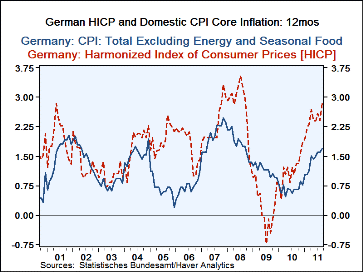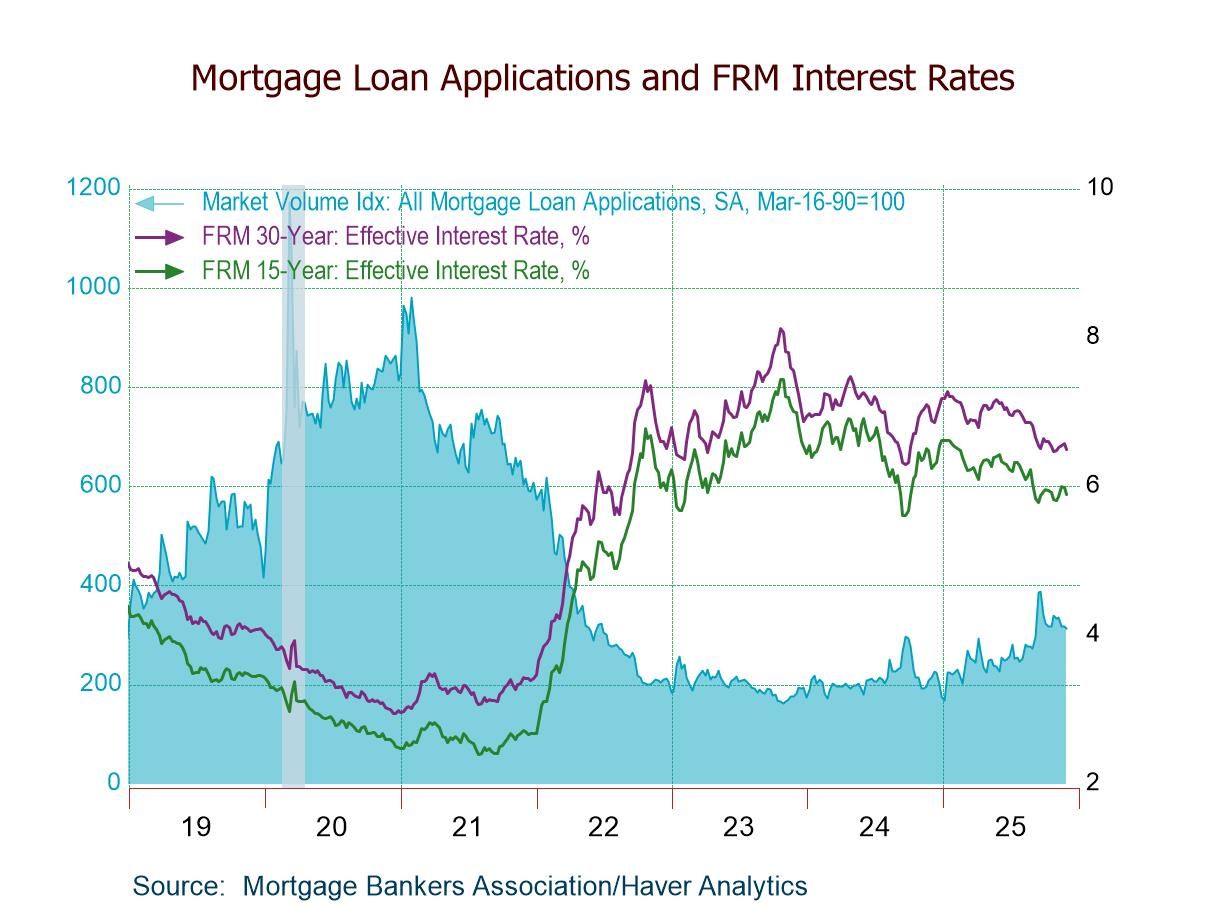 Global| Oct 14 2011
Global| Oct 14 2011German Inflation Flares - So What?
Summary
Embedded in the Euro-Area as it is Germany fights inflation with a tight fiscal policy, a strong constituent belief that inflation is bad and using whatever monetary policies come out of the ECB. The ECB continues to sit and wait. In [...]
 Embedded in the Euro-Area as it is Germany fights inflation with a tight fiscal policy, a strong constituent belief that
inflation is bad and using whatever monetary policies come out of the ECB. The ECB continues to sit and wait.
Embedded in the Euro-Area as it is Germany fights inflation with a tight fiscal policy, a strong constituent belief that
inflation is bad and using whatever monetary policies come out of the ECB. The ECB continues to sit and wait.
In Germany the headline HICP and is up over three-months; core (domestic) inflation has backed off from an elevated six month pace.
Headline HICP inflation is running at 2.9% the German domestic headline rate is up at a 2.5% pace while the German domestic core rate is up at a 1.7% pace. Germany is holding the core rate below the 2% threshold that the ECB holds dear. But the ECB’s sole target for inflation is the headline and it is the headline of the entire EMU area. Meanwhile the diffusion statistics for Germany are telling us that inflation acceleration is not becoming more widespread; it is being a bit less widespread.
With Germany as one of the inflation-‘fightingest’ counties in the Zone its metrics are suggestive of lingering inflation problems elsewhere. Germany’s own headline pace is ‘too strong’ by ECB standards; it’s above 2%. The Core rate that strips out volatile food and energy at 1.7% is just inside the 2% cap. But turning to the EMU data up-to-date through August, all of EMU ran an HICP headline rate of 2.5% and a core rate below Germany’s at 1.5%. One of the reasons that Germany is not –seemingly- doing better on inflation than the Zone, is that Germany has been growing fast and fighting inflation pressure while much of the rest of EMU has been growing slowly or laboring under the corset of austerity and that has retarded growth. After all Germany’s index of industrial output in August is at 99% of its pre-financial crisis peak compared to 92% for the whole of the Zone (which includes the German result) and compared to metrics such as 75% for Greece, 77% for Spain and 84% for Italy.
Still the ECB must make forward looking policy. At the same time it is hard for the ECB run policy based on lower inflation expectations for the future when they are currently embroiled in an overshoot. That is not the situation now but it was the situation early in the financial crisis. As we look ahead today we have the six major German institutes cutting their outlook for German growth and we have the IMF cutting its outlook for world growth. Surely inflation is no longer public enemy number one in this world. Inflation has been reduced from committing transgressions on the order of robbing banks those on the order of jay-walking.
The ECB and all of EMU, the IMF and the US all have much different fish to fry than this. The debt and growth issues are now front and center and the inflation trends are almost- almost- ignorable. But, of course, you can never ignore them and must always be forward looking and therein lies the special problem of this cycle as the Germans worry about moral hazard and the Fed bloats its balance sheet and performs other silly central banker tricks on the view that it will be able to rein-in inflation when it comes time. Can it?
| German HICP and CPI details | |||||||
|---|---|---|---|---|---|---|---|
| Mo/Mo % | SAAR % | Yr/Yr | |||||
| Sep-11 | Aug-11 | Jul-11 | 3Mo | 6Mo | 12Mo | Yr Ago | |
| HICP Total | 0.5% | 0.1% | 0.3% | 3.7% | 1.8% | 2.9% | 1.3% |
| CPI | |||||||
| All | 0.4% | -0.1% | 0.3% | 2.2% | 1.6% | 2.5% | 1.3% |
| CPIxF&E | 0.1% | 0.2% | 0.1% | 1.5% | 1.9% | 1.7% | 0.7% |
| Food | 0.3% | 0.3% | 0.3% | 3.5% | 3.7% | 3.1% | 2.7% |
| Alcohol | 0.1% | 0.4% | 0.1% | 2.5% | 4.1% | 2.3% | 0.2% |
| Clothing & Shoes | 1.6% | -0.3% | 0.4% | 7.0% | 4.1% | 3.0% | 0.5% |
| Rent &Util | 0.4% | 0.0% | 0.4% | 3.2% | 2.1% | 3.3% | 1.6% |
| Health Care | 0.1% | 0.1% | -0.1% | 0.4% | 0.4% | 0.5% | 0.9% |
| Transport | 1.5% | -0.2% | 0.8% | 8.9% | 2.9% | 5.4% | 2.8% |
| Communication | -0.2% | -0.1% | -0.6% | -3.7% | -2.8% | -3.0% | -2.0% |
| Rec &Culture | 0.0% | 0.0% | -0.6% | -2.3% | 1.6% | 1.0% | -0.1% |
| Education | 0.3% | -0.4% | 0.1% | 0.0% | -1.8% | -0.2% | 1.2% |
| Restaurant & Hotel | 0.2% | 0.4% | 0.5% | 4.4% | 3.1% | 1.9% | 1.1% |
| Other | 0.1% | -0.6% | 0.0% | -2.2% | -0.4% | 1.0% | 1.1% |
| Diffusion | 45.5% | 54.5% | 63.6% | -- | |||
| Type: | Diffusion: Current Compared to | 6Mo | 12Mo | Yr-Ago | -- | ||
Robert Brusca
AuthorMore in Author Profile »Robert A. Brusca is Chief Economist of Fact and Opinion Economics, a consulting firm he founded in Manhattan. He has been an economist on Wall Street for over 25 years. He has visited central banking and large institutional clients in over 30 countries in his career as an economist. Mr. Brusca was a Divisional Research Chief at the Federal Reserve Bank of NY (Chief of the International Financial markets Division), a Fed Watcher at Irving Trust and Chief Economist at Nikko Securities International. He is widely quoted and appears in various media. Mr. Brusca holds an MA and Ph.D. in economics from Michigan State University and a BA in Economics from the University of Michigan. His research pursues his strong interests in non aligned policy economics as well as international economics. FAO Economics’ research targets investors to assist them in making better investment decisions in stocks, bonds and in a variety of international assets. The company does not manage money and has no conflicts in giving economic advice.






